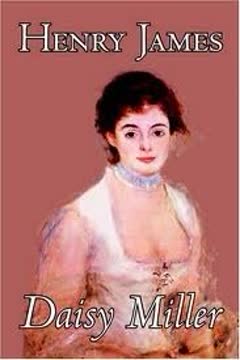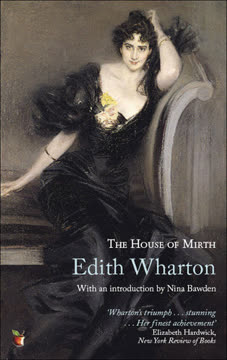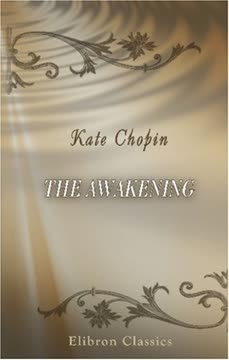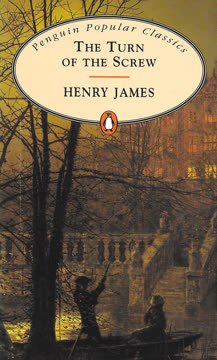Plot Summary
Arrival at the Blue Lake
Frederick Winterbourne, a young American living in Geneva, visits his aunt at a luxurious hotel by Lake Geneva. The town is bustling with American tourists, blending Old World charm with New World energy. Winterbourne, accustomed to European decorum, is both amused and unsettled by the lively, informal atmosphere. His aunt, Mrs. Costello, is often ill and reclusive, leaving him to his own devices. The stage is set for a collision of cultures, as Winterbourne's reserved nature is about to be tested by the arrival of a family that embodies the brashness and innocence of American society abroad.
Daisy's Dazzling Entrance
Winterbourne's idle morning is interrupted by the arrival of Daisy Miller, a strikingly pretty, vivacious young American woman, and her precocious little brother, Randolph. Daisy's openness, directness, and lack of self-consciousness immediately set her apart from the more reserved European women Winterbourne knows. She is charming, talkative, and unguarded, unafraid to speak her mind or make new acquaintances. Winterbourne is both enchanted and perplexed by her, sensing both innocence and a disregard for social conventions. Daisy's presence promises excitement—and trouble—for the careful Winterbourne.
Courting in the Garden
Daisy and Winterbourne quickly develop a playful, flirtatious relationship. Daisy's candidness and disregard for European social codes both attract and unsettle Winterbourne. She talks freely about her family, her travels, and her love of society, revealing a blend of naivety and self-assurance. Winterbourne is fascinated by her, but also puzzled: is she simply an innocent American girl, or a bold flirt unconcerned with propriety? Their easy intimacy is watched with suspicion by others, hinting at the social scrutiny that will soon intensify.
The Chillon Excursion
Daisy expresses a desire to visit the Château de Chillon, and Winterbourne eagerly offers to accompany her. Despite the impropriety of such an outing without a chaperone, Daisy is unconcerned, and her mother is too passive to object. The two spend a delightful day together, Daisy's lightheartedness contrasting with Winterbourne's growing anxiety about appearances. Their excursion becomes the talk of the hotel, marking Daisy as a girl who disregards the boundaries of respectable behavior. Winterbourne is both thrilled and troubled by her disregard for convention.
Aunt Costello's Disapproval
Winterbourne's aunt, Mrs. Costello, refuses to meet Daisy, dismissing her as "common" and lacking in refinement. She warns Winterbourne that Daisy's behavior—her friendliness with couriers, her openness with men—will lead to scandal. Winterbourne defends Daisy's innocence, but Mrs. Costello insists that such ignorance of social codes is itself a kind of vulgarity. The generational and cultural divide is stark: Mrs. Costello represents the rigid, exclusionary standards of old money, while Daisy embodies the new, democratic spirit of America, for better or worse.
Social Rules and Rebellion
Daisy's behavior continues to challenge the expectations of the American expatriate community. She introduces Winterbourne to her mother with casual ease, and openly discusses her friendships with men. Her mother is ineffectual, unable to guide or restrain her daughter. Winterbourne is increasingly drawn to Daisy, but also worries about her reputation. The other Americans in Vevey begin to shun the Millers, and Daisy's isolation grows. Yet she remains cheerful and unrepentant, refusing to let social disapproval dictate her actions.
Reunion in Rome
Months later, Winterbourne travels to Rome, where he finds the Millers have become notorious among the American colony for Daisy's continued flouting of social norms. Daisy is now often seen in the company of Italian men, especially the handsome Giovanelli. Winterbourne is torn between his attraction to Daisy and his fear that she is compromising herself. The stakes are higher in Rome, where the social codes are even stricter and the consequences of transgression more severe. Winterbourne's confusion deepens as Daisy's behavior becomes more provocative.
The Beautiful Giovanelli
Daisy's friendship with Giovanelli, a charming but socially inferior Italian, becomes the focus of gossip and scandal. She is seen walking with him unchaperoned, attending public events, and spending long hours in his company. Winterbourne is both jealous and concerned, unsure whether Daisy is naïve or reckless. Giovanelli's intentions are ambiguous—he flatters Daisy, but his motives are suspect. The American community, led by Mrs. Walker and Mrs. Costello, ostracizes Daisy, but she remains defiant, insisting on her right to choose her own friends.
The Pincio Walk Scandal
Daisy's decision to walk with Giovanelli in the Pincio Gardens, unaccompanied and in full view of society, is the final straw for many. Mrs. Walker, a self-appointed guardian of propriety, tries to intervene, urging Daisy to join her carriage and avoid further scandal. Daisy refuses, laughing off the warnings and continuing her walk with Giovanelli. Winterbourne, caught between loyalty and social pressure, advises Daisy to comply, but she dismisses his concerns. The incident cements Daisy's reputation as a girl who disregards the rules, and her social isolation becomes complete.
Mrs. Walker's Carriage Ultimatum
Mrs. Walker's attempt to "save" Daisy by publicly inviting her into her carriage is met with polite defiance. Daisy refuses, choosing instead to remain with Giovanelli. The American community, watching the scene, interprets Daisy's choice as a deliberate rejection of their values. Winterbourne is forced to choose sides, and his half-hearted support for Daisy only deepens her sense of alienation. The episode marks a turning point: Daisy is now openly shunned, and her reputation is irreparably damaged. Yet she remains outwardly cheerful, refusing to show regret.
Cold Shoulders and Consequences
After the Pincio incident, Daisy is excluded from social gatherings and treated with open disdain by her compatriots. Even Mrs. Walker, once a friend, turns her back on Daisy at a party. Daisy's mother is oblivious, but Daisy herself is wounded by the rejection, though she tries to hide it. Winterbourne continues to visit, but finds Daisy always in the company of Giovanelli. He is tormented by doubts: is Daisy truly innocent, or has she crossed a line? The ambiguity of her character becomes the central mystery of the story.
Daisy's Defiant Flirtation
Daisy's flirtation with Giovanelli grows more intense, and Winterbourne's jealousy and confusion mount. He tries to warn Daisy about the dangers of her behavior, but she laughs off his concerns. The American community's condemnation only seems to strengthen her resolve to live as she pleases. Winterbourne is left to wonder whether Daisy is a victim of her own innocence, or a willful rebel against social norms. The tension between appearance and reality, innocence and experience, becomes acute as Daisy's fate approaches.
The Colosseum by Moonlight
One night, Winterbourne discovers Daisy and Giovanelli alone together in the Colosseum, a place notorious for its unhealthy night air and its associations with romantic intrigue. Winterbourne is horrified, both by the impropriety and by the risk to Daisy's health. He confronts Giovanelli, who shrugs off responsibility, and warns Daisy, who remains blithely unconcerned. The encounter is witnessed by others, and the scandal is complete. Daisy's disregard for convention has now placed her in real danger, both socially and physically.
Roman Fever Strikes
Shortly after the Colosseum incident, Daisy becomes seriously ill with "Roman fever"—malaria contracted from the night air. The American community gossips about her fate, some expressing pity, others satisfaction that she has paid the price for her recklessness. Winterbourne is wracked with guilt and anxiety, visiting the hotel for news and reflecting on his own role in Daisy's downfall. Daisy's mother is distraught, but helpless. The consequences of Daisy's defiance are now tragically clear.
Daisy's Final Message
As Daisy lies dying, she sends a message to Winterbourne: she was never engaged to Giovanelli, and she wants him to remember their time together in Switzerland. The message is ambiguous—an assertion of innocence, a plea for understanding, or a final act of flirtation. Winterbourne is deeply moved, realizing too late that he never truly understood Daisy. Her death is both a personal tragedy and a symbol of the dangers faced by those who challenge the rules of society.
Mourning and Realization
At Daisy's funeral, Winterbourne speaks with Giovanelli, who insists that Daisy was "the most innocent" young lady he ever knew. Winterbourne is struck by the irony: Daisy's innocence, misunderstood by everyone, has led to her destruction. He is left to ponder the meaning of her life and death, and his own failure to protect or understand her. The story ends with a sense of loss and regret, as Winterbourne realizes that Daisy's greatest crime was simply being herself in a world that could not accept her.
Winterbourne's Last Reflection
After Daisy's death, Winterbourne returns to Geneva, haunted by memories and questions. He confesses to his aunt that he may have misjudged Daisy, and wonders if he has become too European, too rigid, to appreciate true innocence. The story closes with Winterbourne's unresolved feelings: admiration, guilt, and a lingering sense of mystery. Daisy Miller remains an enigma—a symbol of the conflict between individual freedom and social constraint, innocence and experience, America and Europe.
Characters
Daisy Miller
Daisy Miller is the story's central figure—a beautiful, lively, and independent young woman from upstate New York. She is both naïve and bold, unafraid to speak her mind or flout social conventions. Daisy's openness and friendliness are interpreted as flirtatiousness by the rigid expatriate community, leading to her social ostracism. She is both a victim of her own innocence and a rebel against the constraints of society. Daisy's tragic fate—her death from Roman fever—underscores the dangers faced by those who refuse to conform. Her character embodies the tension between American individualism and European tradition, and her true nature remains ambiguous to the end.
Frederick Winterbourne
Winterbourne is a young American man educated in Europe, caught between the values of the Old World and the New. He is both attracted to and perplexed by Daisy, unable to decide whether she is an innocent victim or a reckless flirt. Winterbourne's internal struggle—his desire to protect Daisy, his fear of scandal, and his ultimate failure to understand her—drives the narrative. He is both a participant in and a critic of the social codes that destroy Daisy. In the end, Winterbourne is left with regret and self-doubt, symbolizing the limitations of judgment and the cost of cultural dislocation.
Mrs. Costello
Winterbourne's aunt, Mrs. Costello, represents the old, exclusive American elite. She is quick to judge Daisy as "common" and refuses to associate with her. Mrs. Costello's attitudes reflect the social hierarchy and snobbery of the expatriate community. She serves as a foil to Daisy's openness, embodying the values of respectability, caution, and exclusion. Her influence on Winterbourne is significant, reinforcing his doubts and fears about Daisy's behavior.
Mrs. Miller
Daisy's mother is a well-meaning but weak and distracted woman, unable to guide or protect her daughter. She is more concerned with her own ailments than with Daisy's reputation, and her passivity allows Daisy to act as she pleases. Mrs. Miller's inability to enforce social norms or provide emotional support contributes to Daisy's vulnerability. She is both a comic and a tragic figure, illustrating the failures of parental authority in a changing world.
Randolph Miller
Daisy's younger brother, Randolph, is loud, opinionated, and resistant to European ways. He serves as a comic foil, highlighting the cultural differences between Americans and Europeans. Randolph's behavior mirrors Daisy's in its disregard for convention, but without her charm or vulnerability. He represents the untamed, energetic spirit of America, unrefined and unapologetic.
Eugenio
Eugenio is the Millers' Italian courier, a figure of both authority and suspicion. He is treated as a social equal by the Millers, which scandalizes the Americans abroad. Eugenio's presence underscores the Millers' ignorance of social hierarchies and their reliance on outsiders. He is both a protector and a potential corrupter, embodying the ambiguities of class and nationality.
Mrs. Walker
Mrs. Walker is an American expatriate in Rome who tries to "save" Daisy from social ruin. She represents the collective judgment of the community, intervening directly to enforce propriety. Her efforts to control Daisy are well-intentioned but ultimately futile, and her public rejection of Daisy at a party marks the girl's final exclusion. Mrs. Walker's character highlights the limits of social intervention and the cruelty of collective judgment.
Mr. Giovanelli
Giovanelli is a handsome, smooth-talking Italian who becomes Daisy's constant companion in Rome. His intentions are unclear—he flatters Daisy and enjoys her company, but is ultimately self-interested and aware of the social barriers between them. Giovanelli's relationship with Daisy is the catalyst for her final scandal, and his ambiguous role—protector, lover, or opportunist—mirrors the uncertainty surrounding Daisy's own character.
The American Expatriate Community
The collective presence of the American community in Europe serves as a character in its own right, enforcing social norms and punishing transgressors. Their gossip, exclusion, and moralizing create the environment in which Daisy's tragedy unfolds. They embody the tension between old and new values, and their actions reveal the dangers of conformity and the power of collective judgment.
The European Setting
The hotels, gardens, castles, and ruins of Switzerland and Italy are more than mere settings—they symbolize the weight of history, the allure of romance, and the constraints of tradition. The contrast between the freedom of the American characters and the rigidity of European society is played out against this evocative backdrop, shaping the characters' choices and fates.
Plot Devices
Culture Clash and Social Codes
The central plot device is the collision between American openness and European formality. Daisy's behavior, innocent by American standards, is scandalous in the eyes of the expatriate community. The story uses misunderstandings, gossip, and social exclusion to explore the consequences of cultural difference. The narrative structure follows Daisy's increasing isolation, culminating in her tragic death, as a direct result of her inability—or refusal—to conform.
Ambiguity and Unreliable Perception
The story is told largely from Winterbourne's perspective, whose judgments are clouded by attraction, jealousy, and cultural confusion. The ambiguity surrounding Daisy's innocence or guilt is never fully resolved, forcing readers to question their own assumptions. Foreshadowing is used throughout—hints of danger, warnings about "Roman fever," and repeated references to social ruin build tension and anticipation.
Symbolism of Setting and Illness
The settings—the blue lake, the ancient castle, the moonlit Colosseum—are rich with symbolic meaning. The Colosseum, in particular, represents both romantic adventure and mortal peril. Daisy's illness is both literal and metaphorical: her exposure to the "fever" of social judgment is as deadly as the malaria she contracts. The story's structure, moving from light flirtation to dark tragedy, mirrors Daisy's journey from innocence to destruction.
Irony and Tragic Misunderstanding
The plot is driven by irony: Daisy's innocence is interpreted as guilt, Winterbourne's attempts to protect her only contribute to her isolation, and the community's efforts to enforce morality result in tragedy. The final revelation of Daisy's innocence comes too late, underscoring the story's central theme of tragic misunderstanding.
Analysis
"Daisy Miller" is a masterful exploration of the collision between individual freedom and social constraint, innocence and experience, America and Europe. Through the tragic figure of Daisy, Henry James exposes the dangers of rigid social codes and the cruelty of collective judgment. Daisy's refusal to conform—her insistence on living and loving as she pleases—makes her both a symbol of American vitality and a victim of its naivety. The story's enduring power lies in its ambiguity: Daisy is never fully understood, either by Winterbourne or by the reader. Her death is both a warning and a lament, a critique of a society that punishes difference and a celebration of the spirit that dares to defy it. In a modern context, "Daisy Miller" remains a poignant meditation on the costs of nonconformity, the limits of empathy, and the enduring mystery of the human heart.
Last updated:
Review Summary
Daisy Miller receives mixed reviews, with an average rating of 3.37 out of 5. Many readers appreciate James's exploration of cultural clashes between Americans and Europeans, and the portrayal of Daisy as a complex, unconventional character. Some find the novella insightful and well-written, while others criticize it as dated or predictable. The story's ambiguity and James's subtle critique of societal norms are frequently discussed. Several reviewers note the book's significance in James's career and its influence on later works.
Similar Books
Download PDF
Download EPUB
.epub digital book format is ideal for reading ebooks on phones, tablets, and e-readers.









